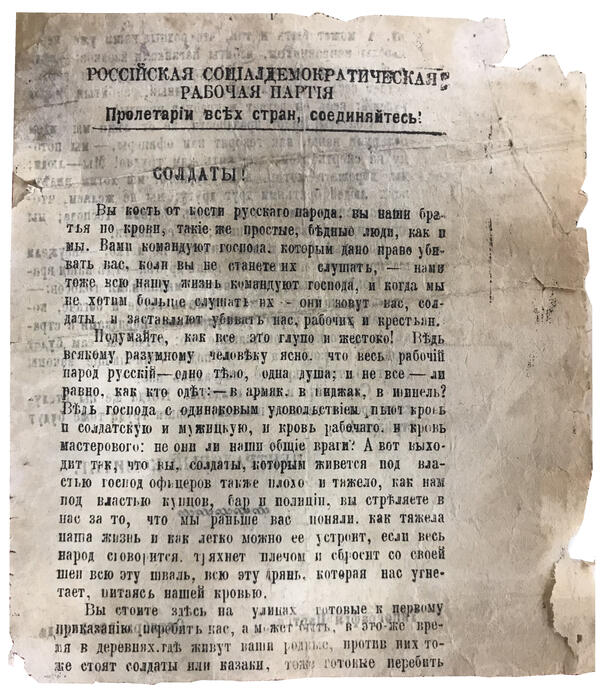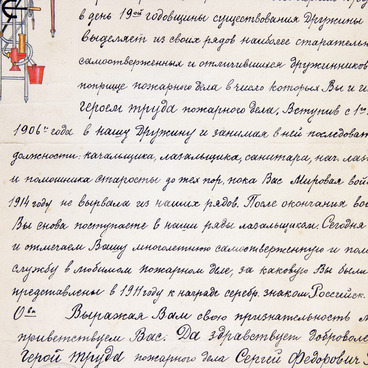In 1905–1907, the Bolshevist party established by Vladimir Lenin launched a massive propaganda campaign among the working class, peasantry, and democratic intelligentsia (public intellectuals). The exposition of the Mytishchi History and Art Museum exhibits a leaflet from that period. The document is poorly preserved due to the bad quality of the paper it was printed on. There is a motto printed on the leaflet: ‘Workers of the world, unite! ’ It was first said in The Communist Manifesto by Karl Marx and Friedrich Engels. The phrase became one of the most famous international Communist slogans. Later, this phrase was put on the USSR coat-of-arms in every language of the Soviet republics.
Leaflets were actively used in revolutionary activities and political campaigns. They were left where people would find them, distributed hand to hand, and posted in different places. The leaflet presented at the exhibition appeals to soldiers. It says, ‘Soldiers! You are bone of the Russian people’s bone, you are our brothers by blood, you are simple, poor people, like us’.
The most active supporters of the Russian Social Democratic Labor Party in Mytishchi were the workers of the Mytishchi pumping station and the Mytishchi Railcar-Building factory. The first organized rally of the factory workers took place in January 1905 and was suppressed by the army. After the January rally, the Bolsheviks only intensified their propaganda campaign at the factory, distributing leaflets of the Moscow Committee of the RSDL Party. In February, police found leaflets urging laborers to stop working on May 1, fight for better salaries, for immediate proclamation of the right for walk-outs, meetings, printing, elimination of police abuse of power, and the immediate conveying of the Constituent Assembly, at the factory.
The next major rally happened in the evening of May 31. About 500 workers gathered by the Gromovy well. The orators arrived from Moscow to call the workers for a strike on June 1. Security agents reported it to the gendarme department and the Moscow governor. About a hundred cossacks arrived at the factory to stay until fall and patrol the territory.
The workers of the Mytishchi factory, about 2,300 people, were among the first to join the October strike in the Moscow Governorate. The morning of December 7, 1905, workers seized the post and telegraph office of Mytishchi. They mobilized an armed detachment and started making blade weapons in the shop. Workers took over Mytishchi and kept order in the town. On December 12, a part of their armed detachment was deployed to assist workers in Moscow where they engaged in a fight on the barricades. Mytishchi also became a zone of tensions. On December 8, the militia took control of the railway station until December 16, 1905. In spite of the obstructions created by the workers, on December 16, a train full of soldiers and carrying two artillery weapons approaches the station. The next day, a police squad and detectives arrived on the scene. A chain of searches and seizures, arrests, and dismissals ensued. In total, 244 people were dismissed from their jobs.
Leaflets were actively used in revolutionary activities and political campaigns. They were left where people would find them, distributed hand to hand, and posted in different places. The leaflet presented at the exhibition appeals to soldiers. It says, ‘Soldiers! You are bone of the Russian people’s bone, you are our brothers by blood, you are simple, poor people, like us’.
The most active supporters of the Russian Social Democratic Labor Party in Mytishchi were the workers of the Mytishchi pumping station and the Mytishchi Railcar-Building factory. The first organized rally of the factory workers took place in January 1905 and was suppressed by the army. After the January rally, the Bolsheviks only intensified their propaganda campaign at the factory, distributing leaflets of the Moscow Committee of the RSDL Party. In February, police found leaflets urging laborers to stop working on May 1, fight for better salaries, for immediate proclamation of the right for walk-outs, meetings, printing, elimination of police abuse of power, and the immediate conveying of the Constituent Assembly, at the factory.
The next major rally happened in the evening of May 31. About 500 workers gathered by the Gromovy well. The orators arrived from Moscow to call the workers for a strike on June 1. Security agents reported it to the gendarme department and the Moscow governor. About a hundred cossacks arrived at the factory to stay until fall and patrol the territory.
The workers of the Mytishchi factory, about 2,300 people, were among the first to join the October strike in the Moscow Governorate. The morning of December 7, 1905, workers seized the post and telegraph office of Mytishchi. They mobilized an armed detachment and started making blade weapons in the shop. Workers took over Mytishchi and kept order in the town. On December 12, a part of their armed detachment was deployed to assist workers in Moscow where they engaged in a fight on the barricades. Mytishchi also became a zone of tensions. On December 8, the militia took control of the railway station until December 16, 1905. In spite of the obstructions created by the workers, on December 16, a train full of soldiers and carrying two artillery weapons approaches the station. The next day, a police squad and detectives arrived on the scene. A chain of searches and seizures, arrests, and dismissals ensued. In total, 244 people were dismissed from their jobs.



